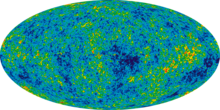| Part of a series on |
| Physical cosmology |
|---|
 |
In physical cosmology, the hadronic epoch[1] started 20 microseconds after the Big Bang.[2] The temperature of the universe had fallen sufficiently to allow the quarks from the preceding quark epoch to bind together into hadrons. Initially, the temperature was high enough to allow the formation of hadron/anti-hadron pairs, which kept matter and anti-matter in thermal equilibrium. Following the annihilation of matter and antimatter, a nano-asymmetry of matter remains to the present day. Most of the hadrons and anti-hadrons were eliminated in annihilation reactions, leaving a small residue of hadrons. Upon elimination of anti-hadrons, the Universe was dominated by photons, neutrinos and electron-positron pairs. This period is referred to as the lepton epoch.
Constituents
In the hadron epoch, it is generally believed that the pion, the lightest meson, was temporarily the most common particle.[1]
See also
Further reading
- Allday, Jonathan (2002). Quarks, Leptons and the Big Bang (2nd ed.). Taylor & Francis. ISBN 978-0-7503-0806-9.
References
- ^ a b Rafelski, J.; Birrell, J.; Steinmetz, A.; Yang, C. T. (June 27, 2023). "A short survey of matter-antimatter evolution in the Primordial Universe". Universe. 9 (7): 309. arXiv:2305.09055. Bibcode:2023Univ....9..309R. doi:10.3390/universe9070309.
- ^ Fromerth, M. J.; Kuznetsova, I.; Labun, L.; Letessier, J.; Rafelski, J. (2012). "From Quark-Gluon Universe to Neutrino Decoupling: 200 < T < 2MeV". Acta Physica Polonica B. 43 (12): 2261. arXiv:1211.4297. doi:10.5506/APhysPolB.43.2261. ISSN 0587-4254. S2CID 118448487.













You must be logged in to post a comment.